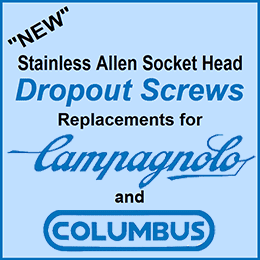Why so short?
 Mon, July 6, 2015
Mon, July 6, 2015  Have you ever pulled the fork from a Fuso, or any other frame I built, and wondered why the thread on the steering tube is so short?
Have you ever pulled the fork from a Fuso, or any other frame I built, and wondered why the thread on the steering tube is so short?
There is about 2 cm. (3/4 in.) of thread, when most frames have as much as 5cm. (2 inches.) of thread.
Actually there is just enough thread to adjust the headset with a few thread turns to spare, so any extra thread is not needed.
But why be so precise, and doesn’t this seem a little OCD? Not really, it is done for a good reason.
After a frame left my shop I had no control over the way it was assembled and set up.
I knew that in the many years this frame would be in use, at some point the owner might raise the quill stem as high as possible, then crank on the expander bolt so tight that it split the steering tube.
 The threaded portion also has a key slot for the headset lock-ring, making it is the weakest portion of the tube.
The threaded portion also has a key slot for the headset lock-ring, making it is the weakest portion of the tube.
And if the handlebar stem expander nut was inside this threaded portion, it would not take much pressure to split or crack the steering tube.
With the thread as short as possible, even if the Handlebar stem was placed dangerously high, way above the limit mark, the expander nut is still inside the plain unthreaded part of the tube where it is its strongest. (See picture below left.)
 Another reason for leaving the threaded end short. A steering tube has to be cut to a precise length.
Another reason for leaving the threaded end short. A steering tube has to be cut to a precise length.
For Campagnolo and most other headsets this was 39mm. longer than the frame head tube. In other words the “Stack” height of a headset was 39mm.
If I didn’t cut the excess from the threaded top end, then I would have to cut it from the bottom end before it was brazed into the fork crown.
Steering tubes come in various lengths, and the framebuilder chooses one that is as close as possible to the required length. The tube is “Butted,” thicker at the bottom end where it takes most of the stress.
A Columbus steering tube also has 6 spiral reinforcing ribs on the inside. By cutting the surplus length from the top threaded end, I retained more of the bottom reinforced end, making a stronger fork.
Incidentally, Columbus always had these spiral ribs inside their steering tubes. It was a feature, and a way to tell if a frame is Columbus. (See picture below.)

Don’t confuse these steering tube spiral ribs, with those inside SLX and TSX tube set. These were introduced in the late 1980s, and had the spiral ribs inside the frame tubes as well.
SLX had the ribs at the butted ends of the tubes. TSX (T for total.) the ribs went the entire length of the tube. (Except the seat tube of course, that had them at the bottom end only, to accommodate the seat post.)
However, the spiral ribs inside the steering tubes had been there for many years, as far as I know from the Columbus tube’s inception.
While I am on this subject, I have read comments online (Mostly by people with little frame design knowledge.) that these spiral ribs inside Columbus SLX and TSX where nothing more than a marketing gimmick. A rip off even.
I strongly disagree. It was a clever way to remove material from inside the tube, thereby saving weight, but at the same time retaining much of the tube’s strength.
A frame is constantly twisting as it is being ridden, especially when climbing, as the rider pushes down on the pedals on one side and pulls up on the handlebars in the opposite direction. A good frame will have a resistance to this twisting, thereby transmitting the power to the rear wheel, rather than the rider's energy being absorbed by the frame.
In order for a frame to twist, each individual tube must twist. The spiral ribs are one way to make a tube that resists twisting. Straight ribs would make little difference, whereas spiral ribs offer resistance to twisting, both with and opposite the direction of the spiral, because the twisting motion is either pushing or pulling directly along the rib.
To Share click "Share Article" below
 Dave Moulton | Comments Off |
Dave Moulton | Comments Off | 

















Reader Comments (8)
I didn't notice the threads on the Paris Sport - now I'm curious! Short, or long?
Andy,
Yours is a fairly large frame, I probably didn't have the luxury of a large stock of varying lengths of steering tubes in stock. I had to use what was available.
Dave.
And with that being said sir , you are the Master !
Just curious, doesn’t tightening the stem cause it to push against the top of the steering tube, where the headset is? The wedge on the bottom of the step splits the aluminum wider at the bottom, so the stem will sit off-angle somewhat, as it won’t just center itself in the steering tube.
Pressure points will be at the bottom of the stem, and where it exits the steering tube, at the top. So having the stem too high will put greater pressure at the top of the steering tube, rather than pressure being more evenly dispersed with it sunk deeper into the steerer tube.
It wouldn’t just be too tight a stem, but also leverage points that will cause steerer tube failure.
Steve,
If there is nothing to stop a person from placing their stem too high, someone is bound to do it. It is why manufacturers put limit marks on components, to make it a no brainer. I agree with the points you raise, but it was seeing forks come through my shop for repair, and in most cases where the steering tube was split or cracked, it was almost always within the treaded and slotted portion. This lead to my practice of making the thread short so it was almost impossible the have the expander nut inside the threaded section.
Dave
Having worked in a bike shop (years ago) looking at a fork tells you volumes about how much care went into a frame. Some production frames show care, others are threaded way down the tube.
As to the ribs, the direction or angle doesn't matter. It is just a matter of increasing the effective wall thickness without the mass of it being full section.
To really appreciate the value of this attention to detail you have to experience a steerer tube break, right at the weak point discussed here, while riding on the road in car traffic. It really does happen, it happened to me on a 1989 Cannondale. Of course it was a mass produce bike and such details can not always be consiidered. Second the master!
The refinisher posted photos on their Facebook page - looks like I DO have a short threaded steerer!!